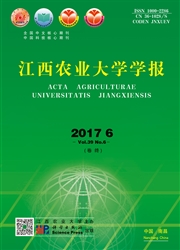

 中文摘要:
中文摘要:
为科学评价辣椒种质资源,应用苗期人工接种鉴定方法和SRAP技术,对204份辣椒种质进行疫病抗性评价和遗传多样性分析。筛选出高抗和抗性材料各8份、中抗材料16份,感病材料172份;抗病材料占供试种质数的比例为15.69%,且主要来自我国南方地区。SRAP分析结果表明,20条引物组合共扩增出585条带,平均每个引物扩增出29.25条,多态性位点比例82.91%。204份材料两两不同种质间Jaccard相似系数0.413~0.996,平均为0.788。通过UPGMA聚类分析,以相似系数0.700为阀值,将204份种质分为7类,有25份抗病材料分布在第Ⅴ类和第Ⅵ类,占全部抗病材料的78.10%。
 英文摘要:
英文摘要:
For scientific evaluation of germplasm resource in pepper,204 germplasms were selected to assess the genetic diversity by SRAP technique and analyze the resistance to Phytophthora capsici by root-irrigating methods.It was found that,8 germplasms were highly resistant,8 resistant,16 moderately resistant,and 172 sensitive.The resistant materials accounted for 15.69% of all the trial germplasms,and most of the resistant materials originated from the southern regions in China. The results of SRAP analysis showed that: twenty primer combinations generated 585 scorable bands,82.91% were polymorphic. Each primer combination amplified an average of 29.25 fragments.Jaccard's similarity between pairs of germplasms ranged from 0.413 to 0.996 with a mean of 0.788.The results from UPGMA cluster analysis suggested that 204 germplasms could be classified into seven groups at similarity coefficient 0.700.Twenty-five resistant materials distributed in the Ⅴ cluster and theⅥ cluster,which occupied 78.10% of all the resistant materials.
 同期刊论文项目
同期刊论文项目
 同项目期刊论文
同项目期刊论文
 期刊信息
期刊信息
